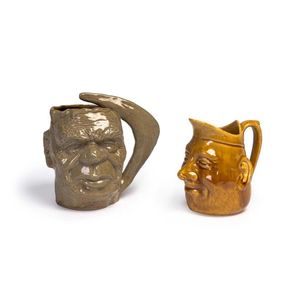Doulton Lambeth Foliate Ewer by Frank Butler
A rare Doulton Lambeth 'foliate' ewer by Frank Butler, with naturalistic stylised foliate form lip and handle and anthemion incised decoration, impressed monogram and 647 model no to the base, 29.5 cm high
You must be a subscriber, and be logged in to view price and dealer details.
Subscribe Now to view actual auction price for this item
When you subscribe, you have the option of setting the currency in which to display prices to $Au, $US, $NZ or Stg.
This item has been sold, and the description, image and price are for reference purposes only.
- Foliate - Decorated with leaves or leaf-like forms.
- Incised - A record of a name, date or inscription, or a decoration scratched into a surface, usually of a glass or ceramic item with a blunt instrument to make a coarse indentation. Compare with engraving where the surface is cut with a sharp instrument such as a metal needle or rotating tool to achieve a fine indentation.
- Anthemion - An anthemion is a classical decorative design element based on the acanthus flower that consists of a central circular or oval motif surrounded by radiating petals or leaves. It is often used as a border or frieze in architecture, furniture, and other decorative arts. The anthemion is derived from the palmette, a motif that was popular in ancient Greek and Roman art and architecture. It is often associated with the classical world and with Neoclassical style, and it is often used to add a sense of grandeur and formality to a design. The anthemion is also known as a honeysuckle or honeysuckle ornament. It continues to be used in a variety of contexts today, and it is often admired for its elegant and decorative qualities.
- Ewer / Pitcher - A type of jug with a narrow neck bulbous body and wide spout, originally used for carrying and storing liquids such as water or wine. In medieval times they were the source of water to wash ones hands during and after a meal. later the shape was used for vessels in silver, gold, glass and ceramics.
In Victorian times they were made in ceramics and occasionally glass with a matching basin, and sometimes other accessories such as a soap holder or toothbrush holder. Their purpose was to provide facilities for personal washing In the early 19th century were often enclosed in purpose built stands, and later resided on a washstand..
Sometimes the words "ewer" and "pitcher" are used interchangably, but a pitcher is generally considered to be a jug, and would have a wide mouth, and a gently tapering body.
This item has been included into following indexes:
- Butler, Frank - Royal Doulton, designers 27
-
Royal Doulton (England), item types
- jugs, other 517
- Lambeth Ware, jugs 98
Visually similar items

A Bendigo Pottery Limited Edition character mug of Albert Namatjira, from the original sculpture by John Firth, No 395 of 3000, and another character jug, 16 cm and 14 cm high
Sold by
in
for
You can display prices in $Au, $US, $NZ or Stg.

Chinese cloisonne bird, with taoist patterning in tones of blue, pink, green and white, length 7.8 cm
Sold by
in
for
You can display prices in $Au, $US, $NZ or Stg.

A Royal Worcester blush ivory lizard decorated ewer. 16 cm high.
Sold by
in
for
You can display prices in $Au, $US, $NZ or Stg.

Remued gumleaf jug in blue glaze (tiniest nip to spout)
Sold by
in
for
You can display prices in $Au, $US, $NZ or Stg.
